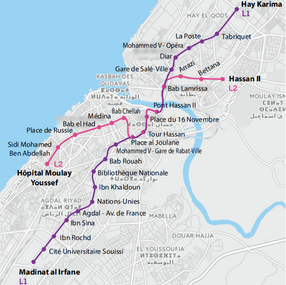Rabat-Salé tram
| Rabat-Salé tram | |
|---|---|
| Citadis of the Rabat-Salé tram | |
| Basic information | |
| Country | Morocco |
| city | Rabat , Salé |
| opening | May 23, 2011 |
| operator | Transdev Group |
| Infrastructure | |
| Route length | 19 km |
| Gauge | 1435 mm ( standard gauge ) |
| Stops | 30th |
| business | |
| Lines | 2 |
| Cruising speed | 20 km / h |
| vehicles | 22 Alstom Citadis |
| Top speed | 70 km / h |
| Route network | |
The Rabat-Salé tram ( Tramway de Rabat-Salé ) is a tram network that went into operation on May 23, 2011 in the Moroccan cities of Rabat and Salé . The network with a length of 19 kilometers comprises two lines and 30 stations and is operated by Transdev Rabat Salé SA with Alstom Citadis trains.
history
The former tram in Rabat
In the first half of the 20th century, during the time of the French protectorate, there was already a tram in Rabat. The railways were steam and gasoline powered. The tram network existed from the 1910s to the early 1930s.
The new tram
As early as 1976, Transroute developed a transport plan that provided for public transport on its own route for the Rabat-Salé agglomeration. Further studies in 1982 and 2003 followed and substantiated the plans. The reason for these plans was the large population growth in this metropolitan area: from 2004 to 2010 the population rose from 1.318 million to over two million.

On this basis, the draft plans for the tram network were completed in 2005 and 2006. The target network comprises four lines and requires two crossings of the Bou-Regreg .
The first phase comprises two lines:
- Line 1 connects Hay Karima (Salé) with the Agdal (Rabat) district, going through the city center on Avenue Al Alaouiyine. This line opens up the main points of the metropolitan area: the avenue Mohammed V in Salé, the government district, the train stations in Rabat and Salé, the faculties and libraries between Bab Rouah and Ibn Zohr, the Agdal district and finally the Bab Al Irfane university campus and the hospital in Souissi.
- Line 2 opens up the densely populated districts of Océan, Yacoub Al Mansour and Bettana (in Salé).
A three-kilometer-long joint section of the two lines serves five stops and includes in particular the crossing of the Bou-Regreg on the new Hassan II bridge.
With the commissioning of the first two lines, there has been a significant change in the modal split . Ultimately, 80% of passengers should be former bus or taxi users and former pedestrians. A significant proportion of the car traffic is to be replaced by the tram, for this purpose three parking spaces have been built at the terminals.
Work on the new tram began in mid-2006 as part of the overall development of the Bou Regreg Valley and was carried out by GTR and the French company Colas.
The trains have a travel speed of 20 km / h and can carry 172,000 passengers per day.
The official opening by King Muhammad VI took place on May 18, 2011, and passenger service began on May 23, 2011, although a 2.5 km long section of Line 2 - from Bab Chellah to the Hôpital Moulay Youssef only a few weeks later in Was put into operation.
Individual evidence
- ^ Ville, Rail & Transport : Inauguration du tramway de Rabat. May 19, 2011. Retrieved June 19, 2011 .
- ↑ [1] Metro Report of May 23, 2011 (English); accessed on October 30, 2017
See also
Web links
- Official website (French)

